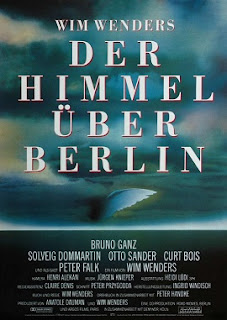Film: Der Himmel über Berlin (1987)
Director: Wim Wenders
Country: Germany
Released: May 1987
Runtime: 127 minutes
Genre: Fantasy
Studio: Road Movies / Argos
Influenced: Terrence Malick, Jim Jarmusch, Michel Gondry, Sofia Coppola, Jean-Pierre Jeunet
The plot follows the journey of two angels, Damiel (Bruno Ganz) and Cassiel (Otto Sander), who watch over the city of Berlin. They can hear other people's thoughts and observe their emotions but are unable to interact directly with them. An early scene of the two angels sat in a car in a BMW showroom comparing notes never fails to move me to tears. Their commitment to "assemble, testify, preserve" all the small, seemingly trivial moments of everyday life is such a noble endeavour, and the scene highlights both the quality of Handke's writing and the beauty of the German language. Damiel becomes so entranced by human experiences that he begins to yearn to experience life in a physical body. Damiel's longing intensifies when he encounters a trapeze artist named Marion (Solveig Dommartin), who is struggling with her own personal issues. Marion is completely intoxicating, and you can see why Damiel wanted to come down from heaven for her.
As he observes her life and inner turmoil, Damiel's desire to become human grows stronger. The plot unfolds as Damiel navigates his feelings and choices, interacting with other humans and fellow angels along the way. One of those ex-angels is the inimitable Peter Falk (playing himself as "der filmstar") and another of the film's life-affirming scenes involves Falk and Ganz talking about the joys of being alive, of drawing, smoking, drinking coffee, etc. I could also watch another scene of Falk trying on hats for hours! The film switches between black & white (angels' view) and colour (human's view) to distinguish perspectives and to provide maximum emotional impact. Also of note in terms of style is Henri Alekan's sublime cinematography; such was Wenders' devotion to the legendary cinematographer that he named the Circus Alekan in the film after him.
Der Himmel über Berlin's employs a poetic and introspective narrative style, with the inner monologues and philosophical musings of the human characters overlapping and dovetailing. One particularly powerful moment is the scene of the two angels, Damiel and Cassiel, walking and talking in unison by the divisive symbol of the Berlin Wall about humanity's long struggle between war and peace. Another notable scene sees Nick Cave performing a live concert with his band, The Bad Seeds, at a nightclub, a key moment of connection between the angelic and human worlds. The film received several awards and nominations, including Best Director for Wenders at Cannes in 1987, and has left a lasting impact on cinema with its innovative storytelling and visual style. Wenders decided to close the film with a farewell tribute to the directors that inspired him – Yasujirō (Ozu), François (Truffaut) and Andrzej (Wajda).

Comments